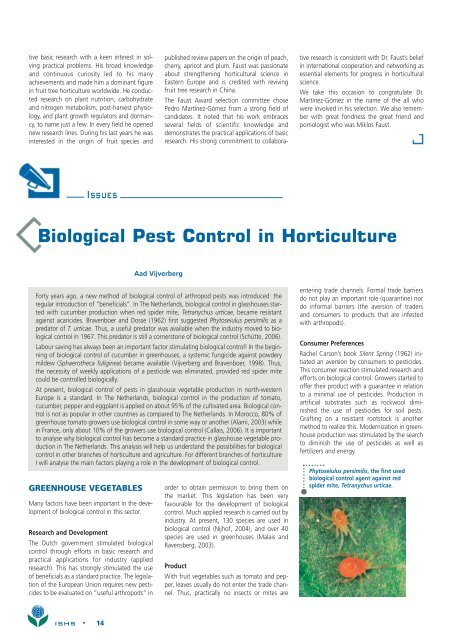Chronica - Acta Horticulturae
Chronica - Acta Horticulturae
Chronica - Acta Horticulturae
Create successful ePaper yourself
Turn your PDF publications into a flip-book with our unique Google optimized e-Paper software.
tive basic research with a keen interest in solving<br />
practical problems. His broad knowledge<br />
and continuous curiosity led to his many<br />
achievements and made him a dominant figure<br />
in fruit tree horticulture worldwide. He conducted<br />
research on plant nutrition, carbohydrate<br />
and nitrogen metabolism, post-harvest physiology,<br />
and plant growth regulators and dormancy,<br />
to name just a few. In every field he opened<br />
new research lines. During his last years he was<br />
interested in the origin of fruit species and<br />
published review papers on the origin of peach,<br />
cherry, apricot and plum. Faust was passionate<br />
about strengthening horticultural science in<br />
Eastern Europe and is credited with reviving<br />
fruit tree research in China.<br />
The Faust Award selection committee chose<br />
Pedro Martínez-Gómez from a strong field of<br />
candidates. It noted that his work embraces<br />
several fields of scientific knowledge and<br />
demonstrates the practical applications of basic<br />
research. His strong commitment to collaborative<br />
research is consistent with Dr. Faust’s belief<br />
in international cooperation and networking as<br />
essential elements for progress in horticultural<br />
science.<br />
We take this occasion to congratulate Dr.<br />
Martínez-Gómez in the name of the all who<br />
were involved in his selection. We also remember<br />
with great fondness the great friend and<br />
pomologist who was Miklos Faust.<br />
ISSUES<br />
Biological Pest Control in Horticulture<br />
Aad Vijverberg<br />
Forty years ago, a new method of biological control of arthropod pests was introduced: the<br />
regular introduction of “beneficials”. In The Netherlands, biological control in glasshouses started<br />
with cucumber production when red spider mite, Tetranychus urticae, became resistant<br />
against acaricides. Bravenboer and Dosse (1962) first suggested Phytoseiulus persimilis as a<br />
predator of T. urticae. Thus, a useful predator was available when the industry moved to biological<br />
control in 1967. This predator is still a cornerstone of biological control (Schütte, 2006).<br />
Labour saving has always been an important factor stimulating biological control! In the beginning<br />
of biological control of cucumber in greenhouses, a systemic fungicide against powdery<br />
mildew (Sphaerotheca fuliginea) became available (Vijverberg and Bravenboer, 1998). Thus,<br />
the necessity of weekly applications of a pesticide was eliminated, provided red spider mite<br />
could be controlled biologically.<br />
At present, biological control of pests in glasshouse vegetable production in north-western<br />
Europe is a standard. In The Netherlands, biological control in the production of tomato,<br />
cucumber, pepper and eggplant is applied on about 95% of the cultivated area. Biological control<br />
is not as popular in other countries as compared to The Netherlands. In Morocco, 80% of<br />
greenhouse tomato growers use biological control in some way or another (Alami, 2003) while<br />
in France, only about 10% of the growers use biological control (Callais, 2006). It is important<br />
to analyse why biological control has become a standard practice in glasshouse vegetable production<br />
in The Netherlands. This analysis will help us understand the possibilities for biological<br />
control in other branches of horticulture and agriculture. For different branches of horticulture<br />
I will analyse the main factors playing a role in the development of biological control.<br />
GREENHOUSE VEGETABLES<br />
Many factors have been important in the development<br />
of biological control in this sector.<br />
Research and Development<br />
The Dutch government stimulated biological<br />
control through efforts in basic research and<br />
practical applications for industry (applied<br />
research). This has strongly stimulated the use<br />
of beneficials as a standard practice. The legislation<br />
of the European Union requires new pesticides<br />
to be evaluated on “useful arthropods” in<br />
order to obtain permission to bring them on<br />
the market. This legislation has been very<br />
favourable for the development of biological<br />
control. Much applied research is carried out by<br />
industry. At present, 130 species are used in<br />
biological control (Nijhof, 2004), and over 40<br />
species are used in greenhouses (Malais and<br />
Ravensberg, 2003).<br />
Product<br />
With fruit vegetables such as tomato and pepper,<br />
leaves usually do not enter the trade channel.<br />
Thus, practically no insects or mites are<br />
entering trade channels. Formal trade barriers<br />
do not play an important role (quarantine) nor<br />
do informal barriers (the aversion of traders<br />
and consumers to products that are infested<br />
with arthropods).<br />
Consumer Preferences<br />
Rachel Carson’s book Silent Spring (1962) initiated<br />
an aversion by consumers to pesticides.<br />
This consumer reaction stimulated research and<br />
efforts on biological control. Growers started to<br />
offer their product with a guarantee in relation<br />
to a minimal use of pesticides. Production in<br />
artificial substrates such as rockwool diminished<br />
the use of pesticides for soil pests.<br />
Grafting on a resistant rootstock is another<br />
method to realize this. Modernization in greenhouse<br />
production was stimulated by the search<br />
to diminish the use of pesticides as well as<br />
fertilizers and energy.<br />
Phytoseiulus persimilis, the first used<br />
biological control agent against red<br />
spider mite, Tetranychus urticae.<br />
ISHS • 14
















